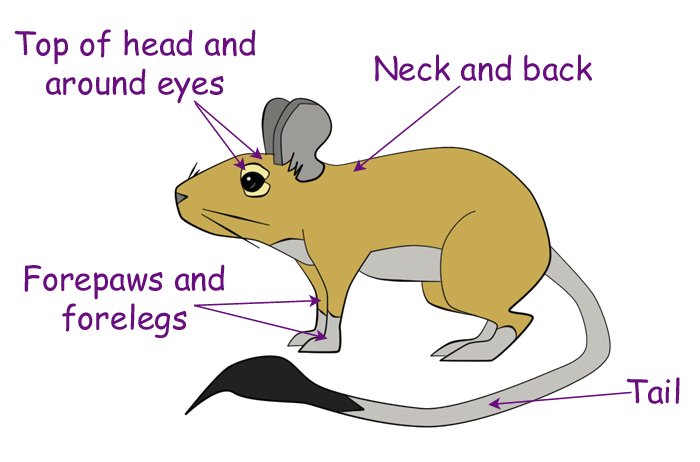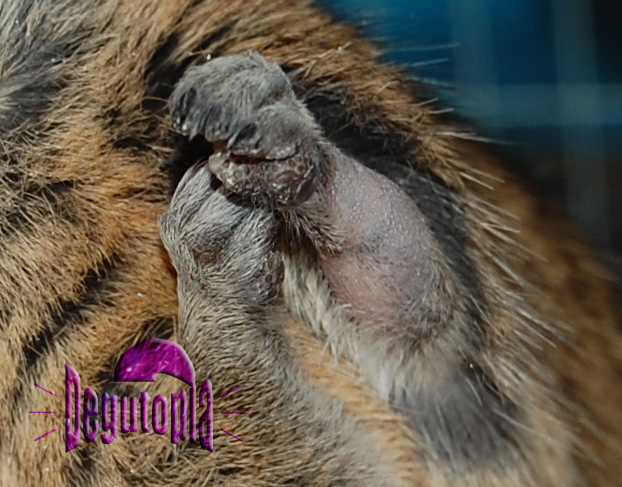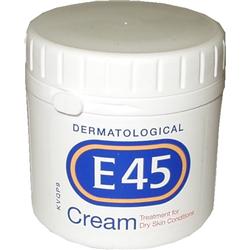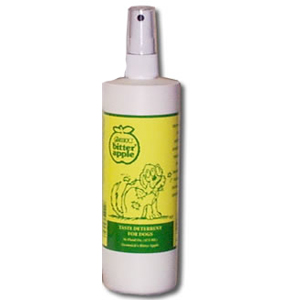
Fur-pulling is one of the most common behavioural complaints that captive degus can suffer from. Fur-pulling may also be referred to as 'barbering' or 'self-mutilation'. Owners are usually made aware of the problem
when bald patches of bare skin start to appear on a degu's body in specific locations. If you suspect one of your degus may be fur-pulling, this guide can help
you to diagnose and to treat the problem.
>How do I know if my degu is fur-pulling?<
Fur-pulling can be identified from other conditions causing baldness because
the exposed skin looks otherwise healthy, and is typically not flaky, sore or weeping- check the other conditions on the
illness page (jump to FUR and SKIN). Also the areas of exposed skin are usually in one or more of a few very specific locations, as shown
in the picture below:


Example of fur-pulling on the foreleg of a degu.
>What causes fur-pulling?<
Fur-pulling is a purely behavioural disorder, known as a 'stereotypy'. It's a bit like a bad habit in humans, like biting your finger nails. Stereotypies are formed
initially under some sort of stress that the degu is experiencing on a regular basis- it's the result of the degu's attempts to 'cope' with the stress. Note that there
are other forms of stereotypy, such as bar-chewing, but by far the most common in the degu is this one. Fur-pulling is actually a form of over-grooming, and degus
perform this behaviour usually once they've begun grooming and are sitting or resting- it is not an aggressive action. During fur-pulling sessions, the degu
will sit, begin grooming and then start gently pulling out hairs with their teeth in one of the areas shown above. The degu does this over and over on a very
regular basis, resulting in bald, furless areas in these locations because the new hairs don't have a chance to grow back fully before being pulled out again.
Note that it isn't always the degu with bald patches that is doing the pulling! Whilst pulling hair from the paws or tail can be done themselves, reaching the
top of the head or back is impossible and in these cases it is a cage-mate that is performing the behaviour (usually a more dominant degu). It is therefore important
to watch the degus closely while they are grooming to see if you can catch the culprit- this is the one that needs treating!
>How do I determine what is stressing my degu?<
Now you know that the cause of fur-pulling is stress, in order to treat the problem effectively it's essential to first work out what is causing your degu to feel
stressed. Due to the nature of stereotypies, it is often the case that the disorder persists even long after the source of the stress has gone, so it's very important
to catch the problem and correct it early on, before the behaviour becomes more habitual. There are many things that can cause your degu to feel stressed enough
on a daily basis to develop a stereotypy, below are listed just a few examples of common ones you can explore first:
 Cage/enclosure size not large enough- degus are active animals and need plenty of space to perform a full range of normal behaviours.
If their cage is too small for their needs this can cause them extreme stress, so be sure to check your cage is large enough for the number of degus you have
(see the cage space calculator on the housing page). Remember, the bigger the better!
Cage/enclosure size not large enough- degus are active animals and need plenty of space to perform a full range of normal behaviours.
If their cage is too small for their needs this can cause them extreme stress, so be sure to check your cage is large enough for the number of degus you have
(see the cage space calculator on the housing page). Remember, the bigger the better!
 Sudden reduction in cage size- as above, if your degus are used to a larger enclosure and suddenly find their
living space restricted, this can trigger stress-related disorders.
Sudden reduction in cage size- as above, if your degus are used to a larger enclosure and suddenly find their
living space restricted, this can trigger stress-related disorders.
 Reduction in the frequency or length of play times- again, degus really need plenty of space not only for exercise but
also for important mental stimulation (degus are smart cookies!). For this reason regular play times outside the cage are important to them and eagerly anticipated.
If for some reason you've had to reduce their play times, this can adversely affect their welfare, so try to keep regular, predictable play times for at least half
an hour per day. Your degus will thank you for it, and it gives you time to play with them, too!
Reduction in the frequency or length of play times- again, degus really need plenty of space not only for exercise but
also for important mental stimulation (degus are smart cookies!). For this reason regular play times outside the cage are important to them and eagerly anticipated.
If for some reason you've had to reduce their play times, this can adversely affect their welfare, so try to keep regular, predictable play times for at least half
an hour per day. Your degus will thank you for it, and it gives you time to play with them, too!
 Lack of environmental stimulation- degus are very intelligent and need things to occupy their minds. Be sure your degus
have plenty to do inside their cage, including toys and puzzles to work out (some great suggestions can be found on the enrichment page).
Give them novel objects to investigate regularly and try to engage them with some training work- they love working things out!
Lack of environmental stimulation- degus are very intelligent and need things to occupy their minds. Be sure your degus
have plenty to do inside their cage, including toys and puzzles to work out (some great suggestions can be found on the enrichment page).
Give them novel objects to investigate regularly and try to engage them with some training work- they love working things out!
 Sudden change to the group- any sudden change to the group size, such as the removal or addition of new degus can
be very stressful to the existing members. Remember that degus form a complex social hierarchy which will need to be adjusted to
accommodate any changes to
the group- in particular this may stress the dominant degu of the group more than others.
Sudden change to the group- any sudden change to the group size, such as the removal or addition of new degus can
be very stressful to the existing members. Remember that degus form a complex social hierarchy which will need to be adjusted to
accommodate any changes to
the group- in particular this may stress the dominant degu of the group more than others.
 Social isolation- degus are highly social animals and can
develop a whole range of physical and mental problems
if housed alone, even if you do your best to give them a lot of attention. Being housed singly is a very common cause of fur-pulling stress in degus, and it's
so easy to treat by integrating a same-sex friend.
Social isolation- degus are highly social animals and can
develop a whole range of physical and mental problems
if housed alone, even if you do your best to give them a lot of attention. Being housed singly is a very common cause of fur-pulling stress in degus, and it's
so easy to treat by integrating a same-sex friend.
 Illness- a degu who has a long-term illness or is taking more than a few weeks to recover may start to suffer from stress
if they feel unwell for prolonged periods. Illness can also be linked to changes in the social structure of the group, particularly if the dominant degu falls ill and
can no longer maintain their place at the top- this can cause stress not only to the ill degu but to the other group members, too, which is something to watch out for.
Illness- a degu who has a long-term illness or is taking more than a few weeks to recover may start to suffer from stress
if they feel unwell for prolonged periods. Illness can also be linked to changes in the social structure of the group, particularly if the dominant degu falls ill and
can no longer maintain their place at the top- this can cause stress not only to the ill degu but to the other group members, too, which is something to watch out for.
 Introduction of a new pet to the household- any new pet can
indirectly cause stress to your degus, even if they aren't
kept in the same room. Any large predatory animals like cats and dogs will leave their scent on your clothing, making your degus wary. Even a new pet rabbit can cause
stress to your degus indirectly if it impacts on them in some way, such as reducing the time you spend with them each day. However, more direct stress can occur
if a new dog or cat visits the degus' cage on a regular basis. Degus are very territorial and feel they need to defend their 'safe space' from 'predators', even if they
intend them no real harm, so try to keep your other pets away from the degu cage.
Introduction of a new pet to the household- any new pet can
indirectly cause stress to your degus, even if they aren't
kept in the same room. Any large predatory animals like cats and dogs will leave their scent on your clothing, making your degus wary. Even a new pet rabbit can cause
stress to your degus indirectly if it impacts on them in some way, such as reducing the time you spend with them each day. However, more direct stress can occur
if a new dog or cat visits the degus' cage on a regular basis. Degus are very territorial and feel they need to defend their 'safe space' from 'predators', even if they
intend them no real harm, so try to keep your other pets away from the degu cage.
 Changing the position of the cage or a change in their regular routine- change is something that can be really stressful
for degus, as they are naturally prey animals and wary of anything new. While it's reasonable to assume that moving to a brand new house can be stressful for
your degus, many people may not realise that even moving the position of their current cage can be just as stressful for them! Also changing their regular routine,
such as feeding times, can be stressful until they get used to the new pattern, so try to stick to a regular schedule with them.
Changing the position of the cage or a change in their regular routine- change is something that can be really stressful
for degus, as they are naturally prey animals and wary of anything new. While it's reasonable to assume that moving to a brand new house can be stressful for
your degus, many people may not realise that even moving the position of their current cage can be just as stressful for them! Also changing their regular routine,
such as feeding times, can be stressful until they get used to the new pattern, so try to stick to a regular schedule with them.
 Removal of a running wheel in the cage- this may sound a little trivial, but it can cause your degus a great deal of upset!
Degus really rely on their in-cage running wheel for daily exercise, so if it breaks suddenly or is removed, they can get very upset!
Removal of a running wheel in the cage- this may sound a little trivial, but it can cause your degus a great deal of upset!
Degus really rely on their in-cage running wheel for daily exercise, so if it breaks suddenly or is removed, they can get very upset!
Please note that this list provides just a few of the most common causes of fur-pulling related stress in degus- there can be many other causes, too! However, in all cases
the important thing to note is that the cause of stress will have started around the same time as the fur-pulling began, so you will need to think back to when you
very first noticed the problem starting, and see if you can link it with a change to your degus' environment.
>OK, so now how do I treat the problem?<
Treating the problem is fairly easy once you have pinpointed the cause (that's the more tricky part), as long as you act promptly. Remember that the longer the
degu has had the habit of fur-pulling, the harder it will be to correct. Treatment is most effective when you use a combination of direct (treating the process of
fur-pulling) and non-direct (removing the source of the stress) treatments. It is VERY IMPORTANT to underline that you must not use direct treatment
only, i.e. prevent the degu from fur-pulling. Doing so will not fix the problem if you don't also remove the cause of stress, and so you may cause the degu to
develop an alternative stereotypy in order to compensate. That won't help the degu at all!
Non-direct treatment of the source of stress:
Right, so now that you've linked a potential source of stress with the start of the fur-pulling, you'll need to do your best to reverse the change that caused the
stress. If you think this was caused by a broken running wheel, for example, all you need to do is to replace the running wheel and your degu's stress levels
should decrease again. Other things may not be so easy to treat, for example if the stress was caused by moving house. In these cases just do your best to
reduce your degu's stress levels, such as by keeping them in a quiet room to settle in for a few weeks. If you can think of more than one change that may be
the cause of stress, you should try correcting both. Note that treating the source of stress alone may or may not
stop the fur-pulling, often direct treatment is also needed just to get the degu to break the habit (see below).
Direct treatment of the fur-pulling:
Once you have done the non-direct treatment to remove the source of the stress, you can now directly treat the fur-pulling behaviour. The best method of
doing this we have found is to both treat the skin, and apply a taste deterrent to the bald patch. Moisturising the skin will help the skin to recover if it has dried
out a bit, and also we find helps discourage the degu from chewing the area. Any mild, unscented moisturiser suitable for use on human infants can be used,
we recommend E45 cream or Sudocrem. Apply this once or twice daily to the skin and rub it in a little. Afterwards, it helps to apply a taste deterrent to the
area such as bitter apple spray. A brand I use often is Grannick's, any type, which can be bought on ebay. Apply it directly onto the skin (don't use on sore or
broken skin) once or twice daily, being careful not to get any near the degu's mouth or the soles of their forepaws where they hold food- apply with a cotton bud
if necessary. Continue with treatment until you notice fine hair re-growth in the bald areas. Just to stress again, do not treat the problem with this method alone! This is complimentary to the
non-direct method and not an alternative.



Above: E45 cream, Sudocrem and Grannick's bitter apple spray.





 Cage/enclosure size not large enough-
Cage/enclosure size not large enough- 

